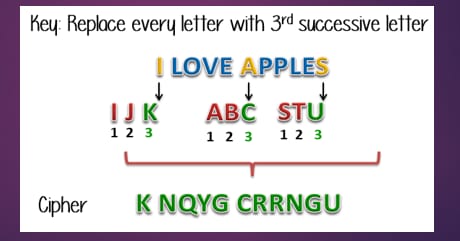Cryptography Tutorial:Cryptanalysis
Information plays an important role within the running of business, organizations, military operations, etc. Information within the wrong hands can cause loss of business or catastrophic results. To secure transmission, a business can use cryptology to cipher information. Cryptology involves transforming information into the Nonhuman readable format and the other way around .
What is Cryptography?
Cryptography is that the study and application of techniques that hide the important meaning of data by transforming it into nonhuman readable formats and the other way around .
Let’s illustrate this with the help of an example. Suppose you would like to send the message “I LOVE APPLES”, you’ll replace every letter within the phrase with the third successive letter within the alphabet. The encrypted message are going to be “K NQXG CRRNGV”. To decrypt our message, we’ll need to return three letters within the alphabet using the letter that we would like to decrypt. The image below shows how the transformation is completed .
The process of remodeling information into nonhuman readable form is named encryption.
The process of reversing encryption is named decryption.
Decryption is completed employing a secret key which is merely known to the legitimate recipients of the knowledge . The key’s wont to decrypt the hidden messages. This makes the communication secure because albeit the attacker manages to urge the knowledge , it’ll not add up to them.
The encrypted information is understood as a cipher.

What is Cryptanalysis?
Cryptanalysis is that the art of trying to decrypt the encrypted messages without the utilization of the key that was wont to encrypt the messages. Cryptanalysis utilizes mathematical analysis & algorithms to decipher the ciphers. The success of cryptanalysis attacks depends
*Amount of your time available
*Computing power available
*Storage capacity available
The following may be a list of the commonly used Cryptanalysis attacks;
a)Brute force attack– this sort of attack uses algorithms that attempt to guess all the possible logical combinations of the plaintext which are then ciphered and compared against the first cipher.
b)Dictionary attack– this sort of attack uses a wordlist so as to seek out a match of either the plaintext or key. it’s mostly used when trying to crack encrypted passwords.
c)Rainbow table attack– this sort of attack compares the cipher text against pre-computed hashes to seek out matches.
What is cryptology?
Cryptology combines the techniques of cryptography and cryptanalysis.
Encryption Algorithms:
a)MD5– this is often the acronym for Message-Digest 5. it’s wont to create 128-bit hash values. Theoretically, hashes can’t be reversed into the first plain text. MD5 is employed to encrypt passwords also as check data integrity. MD5 isn’t collision resistant. Collision resistance is that the difficulties find two values that produce an equivalent hash values.
b)SHA– this is often the acronym for Secure Hash Algorithm. SHA algorithms are wont to generate condensed representations of a message (message digest). it’s various versions such as;
*SHA-0: produces 120-bit hash values. it had been withdrawn from use thanks to significant flaws and replaced by SHA-1.
*SHA-1: produces 160-bit hash values. it’s almost like earlier versions of MD5. it’s cryptographic weakness and isn’t recommended to be used since the year 2010.
*SHA-2: it’s two hash functions namely SHA-256 and SHA-512. SHA-256 utilizes 32-bit words while SHA-512 uses 64-bit words.
*SHA-3: this algorithm was formally referred to as Keccak.
c)RC4– this algorithm is employed to make stream ciphers. it’s mostly utilized in protocols like Secure Socket Layer (SSL) to encrypt internet communication and Wired Equivalent Privacy (WEP) to secure wireless networks.
d)BLOWFISH– this algorithm is employed to make keyed, symmetrically blocked ciphers. It are often wont to encrypt passwords and other data.